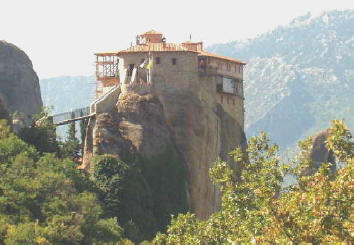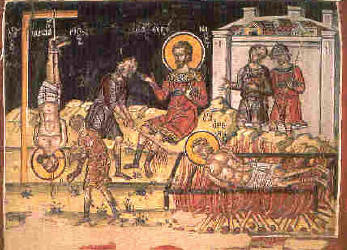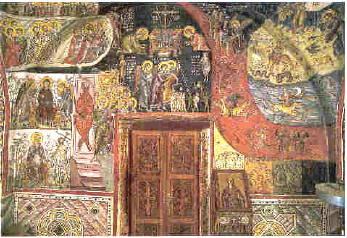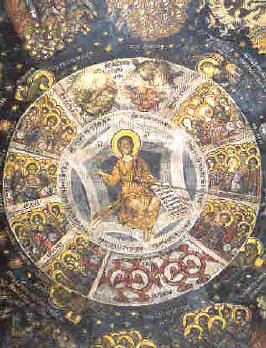|
The Holy Monastery of Rousanou is situated on the southeastern side of
the Great Meteoron monastery and between the Varlaam and the Holy
Trinity Monasteries.
 Above
Kalambaka and the village Kastrak, visitors come to terms with the first
monastery, the monastery of Saint Nickolas Anapafsas, a monastery that
lies on their left hand side. Above
Kalambaka and the village Kastrak, visitors come to terms with the first
monastery, the monastery of Saint Nickolas Anapafsas, a monastery that
lies on their left hand side.
The monastery of Rousanou stands just before us on a spectacular
vertical cliff of the stone forest of Meteora.
The complex of buildings covers the entire top of the cliff. Visitors
and pilgrims may enjoy the grandeur and magic that the unique Meteorite
landscape has to offer them from up there.
In the background, the Mount Koziakas, the River Pineios and the village
Diava are clearly discernible.
Until 1897, the
ascent to the monastery was carried out by means of ladders.
Later on, two wooden bridges had been
employed to serve the monks and the visitors.
Today, the ascent to the monastery premises is achieved through a
flight of stairs made of cement and two small bridges, constructed in
1930, which had been donated to the monastery by a local resident named
Laurel Bouka.

There is no
verifiable evidence to justify the name of the monastery. It is possible
that the monastery has been named after the
first owner of the original church (14th
-15th century). The monastery had not been inhabited
until 1388 AD by the monks Nicodemus and Benedict. Historical resources
have not been established so far.
At the beginning, the monastery functioned as a priory by the monk
brothers Maximus and Iosafath from Ioannina.
The monastery was
built on the ruins of older facilities in the middle of the 14th
– 15th century. It started functioning as soon as it received
the blessing of the Bishop of Larisa,
Bessarion the second and the consent of the Abbot of the Monastery of
the Great Meteoron. They erected the holy monastery of the
Transfiguration of Jesus Christ and gave its current shape. They also
built cells for the monks and supplementary rooms on the floors.

The monastery
consists of a three-storey complex. On the ground floor, there are cells
with reception rooms, the Archontariki and other supplementary
facilities located on the rest of the floors.
The Katholikon of
the monastery is a dikioni crossed church with a tall dome, a domed
Narthex and a flat wooden Iconostasis.
The
Monastery has great murals in a style that belongs to the Cretan School
and to our church’s historical and doctrinal area.
The inscription above the entrance of the monastery informs us that the
paintings were made in 1560 AD. with the venerable Abbot’s assistance
and maintained in a good condition despite the unrelenting passage of
time.
In the 1980s,
there had been a major renovation and restoration of the monastery under
the supervision of the 7th Inspectorate of the Byzantine
Antiquities.
Today, the
monastery serves as a nunnery. 
The temple is
dedicated to the Transfiguration of Jesus Christ and simultaneously the
memory of Saint Barbara which is reverently honored on December 4th.
In times of
national distress and during the dark ages of the Turkish occupation
several residents of Kalambaka and Trikala turned to the monastery to
get saved.
Today, the monastery‘s brotherhood is following a coenobitic way of
life according to the prearranged Orthodox monastic norms and under the
consistent guidance of our spiritual leaders.
The practice of monastic life complies with the requirements set by our
holy Fathers and the Orthodox Church and constitutes the members’ of
this monastery primary concern.
There is some social activity and visitors’ spiritual support offered by
the nuns who draw their strength from the miraculous grace of the Saint.
Translation by Christine Boutsia |
